Physical Address
304 North Cardinal St.
Dorchester Center, MA 02124
This chapter focuses on the use of immunohistochemistry (IHC) in the setting of diagnostic gynecologic pathology. The first section describes the properties and applications of most useful antibodies for the evaluation of lesions in the gynecologic tract. The second section discusses immunohistochemical stains in the context of specific tumors by anatomic site: (1) vulva, vagina, and cervix; (2) uterus; (3) ovary and fallopian tube; and (4) peritoneum. The focus of this chapter is on diagnostic IHC, but we wish to emphasize that antibodies must be used and stains must be interpreted in conjunction with careful assessment of routine hematoxylin and eosin (H&E)-stained slides and clinicopathologic correlation.
Keratins are intermediate filament proteins that contribute to the cytoskeleton of epithelial cells. Because they are present in all epithelial cells, immunostains for cytokeratins (CKs) are useful as a screening test to identify a neoplasm as being of the epithelial type. Human CKs have been classified according to their molecular weights and isoelectric pH values in the catalog published by Moll and colleagues. Some of these have specific tissue distributions, which can be exploited for the differential diagnosis of tumors. For screening purposes, a wide-spectrum antibody that recognizes many different CKs is most valuable. We use a cocktail of AE1/AE3 and CAM5.2.
Expression of CKs AE1/AE3 and CAM5.2 is usually sufficient to confirm epithelial differentiation in tumors of most organ systems. However, cytokeratin expression is not limited to epithelial cells. Both endometrial stromal and smooth muscle cells have shown cytokeratin expression, although much more weakly than in epithelial cells. Sex cord–stromal neoplasms can also express focal to patchy keratin. Epithelial membrane antigen (EMA) is usually not expressed in these nonepithelial tumors.
CK7 is a type II basic low-molecular-weight cytokeratin (LMWCK) that is found in simple epithelia in a variety of organs, including all epithelia in the female genital tract. , Epithelial tumors of the ovary and fallopian tube exhibit cytoplasmic and/or membranous staining for CK7. This characteristic staining pattern of female genital tract tumors can be used, usually in combination with staining for other keratins such as CK20, to differentiate primary female genital tract adenocarcinomas from those arising in other organs. A panel of immunostains must be evaluated because some primary ovarian neoplasms fail to stain for CK7, and a proportion of metastatic carcinomas in the ovary are CK7 positive.
CK20 is a type I acidic LMWCK. It is found in normal tissues of the stomach, intestine, urothelium, and in Merkel cells, and it is expressed in most adenocarcinomas of the large and small intestines, in some mucinous tumors of the ovary, and in Merkel cell carcinomas. It is frequently present in urothelial carcinoma and in adenocarcinoma of the stomach, pancreas, and bile ducts. , CK20 is a useful marker for primary mucinous tumors of the ovary and for various types of metastases found in the ovaries. Most primary nonmucinous ovarian epithelial tumors are CK20 negative.
PAX8, a member of the paired box (PAX) family of transcription factor genes, is expressed in the müllerian tract. It is useful in distinguishing müllerian tract carcinomas from malignant mesotheliomas and metastases, particularly breast, colon, and lung carcinomas. In addition to the müllerian tract, PAX8 is expressed in thyroid, parathyroid, renal, and thymic carcinomas. Although PAX8 expression has also been reported in pancreatic neuroendocrine tumors, appendiceal and rectal carcinoids, and B-cell lymphomas, the observed PAX8 positivity in these tumors is due to a cross-reactivity of the polyclonal antibody used with the N-terminal region of PAX6 and PAX5; it is not seen with monoclonal PAX8 antibody. Its expression is nuclear and typically strong and diffuse in müllerian tumors; focal weak expression is not specific, because this degree of staining may be seen in a variety of other neoplasms. It should be noted that mesothelial cells, both in benign and malignant processes, may sometimes show PAX8 expression, so distinguishing mesothelial versus müllerian epithelium should always involve more than one marker.
Antibodies that are reactive against adenocarcinoma but nonreactive with mesothelial cells are used in a panel for the differential diagnosis between adenocarcinoma and mesothelioma. Antibodies that have been used for this purpose include CD15, BerEP4, monoclonal carcinoembryonic antigen (mCEA), and MOC-31. CD15 (LeuM1) is used mainly in hematopathology, but it also stains various adenocarcinomas. Positive staining is reported in approximately one-third to two-thirds of ovarian serous carcinomas and in a higher percentage of endometrioid and clear cell adenocarcinomas. , Staining can be either granular and cytoplasmic or membranous. BerEP4 is a monoclonal antibody directed against glycoproteins on epithelial cells, and it shows diffuse, strong membrane staining in nearly all serous carcinomas of the ovary and peritoneum. , In ovarian cancers, mCEA is rarely positive, with the exception of mucinous adenocarcinoma, which is typically carcinoembryonic antigen (CEA) positive. , Areas of squamous differentiation in endometrioid adenocarcinoma can also show staining for CEA. Polyclonal CEA (pCEA) appears to be less specific than mCEA and stains a somewhat greater percentage of ovarian carcinomas. B72.3 is a monoclonal antibody against a tumor-associated glycoprotein (TAG-72). It is usually positive in carcinomas of the ovary and exhibits a granular cytoplasmic staining pattern. , , This stain can be difficult to interpret, because there is often background staining of mucin and other secretions. MOC-31 is a monoclonal antibody against a glycoprotein that shows strong membrane staining in most cases of ovarian cancer. All of these antibodies are negative or only rarely immunoreactive in mesothelioma. In general, BerEP4, MOC-31, and B72.3 are more sensitive for the detection of ovarian surface epithelial tumors than are LeuM1 and CEA.
Carbohydrate antigen 125 (CA-125) is a high-molecular-weight (HMW) glycoprotein recognized by the monoclonal antibody OC125. CA-125 is commonly expressed by primary nonmucinous epithelial ovarian cancers, but it also can be expressed by various other gynecologic cancers, which include tumors of the cervix, endometrium, and fallopian tube, and by certain nongynecologic cancers, such as those of pancreas, breast, colon, lung, mesothelium, and thyroid. Evaluation for the expression of CA-125 (OC125) is of limited value, because female genital surface epithelial proliferations, metastatic carcinomas from extragenital sites, and mesothelial proliferations can all express CA-125. ,
A tumor suppressor protein that is a cyclin-dependent kinase inhibitor, p16 is essential in regulating the cell cycle, and it inactivates cyclin-dependent kinases that phosphorylate retinoblastoma (Rb); therefore, p16 can decelerate the cell cycle. Rb phosphorylation status in turn influences expression of p16. In human papillomavirus (HPV) infection, the HPV oncogenes E6 and E7 can inactivate phosphorylated Rb (pRb) and thus lead to p16 over-expression. Therefore p16 over-expression is a surrogate biomarker of HPV infection, the high-risk HPV types in particular, which makes it useful in evaluating HPV-associated squamous and glandular neoplasia of the lower gynecologic tract. HPV-independent mechanisms of p16 over-expression also exist, so p16 expression may be observed in tumors that do not necessarily harbor HPV infection, such as high-grade serous carcinoma. The intensity and distribution of p16 is important in interpretation as well as in nuclear versus cytoplasmic localization. Positive staining is defined as diffuse strong nuclear and cytoplasmic staining. For squamous lesions of the lower genital tract, this must be present in the lower one-third of the epithelium, with extension into the upper two-thirds. For carcinomas in the uterus and ovary, the staining should be seen in almost all cells. We report p16 as “positive (diffuse nuclear and cytoplasmic staining)” or “negative (absent to patchy staining only).”
The TP53 gene encodes the p53 protein, which is a DNA-binding protein that induces expression of downstream proteins responsible for cell growth inhibition. It is classified as a tumor suppressor gene. Most of the mutations in TP53 are frameshift or nonsense mutations that increase the stability of the protein, leading to accumulation detectable by immunohistochemical staining. This pattern results in abnormal diffuse nuclear over-expression of p53 in greater than 90% of the tumor cells. However, sometimes the mutations are insertions, deletions, or stop codons leading to lack of p53 production. These mutations result in the null-pattern of p53 expression with complete lack of nuclear staining in the tumor cells. A normal expression pattern of p53 shows patchy nuclear staining. TP53 mutations are most commonly seen in high-grade serous carcinoma (all sites); however, TP53 mutations, and thus abnormal immunohistochemical staining patterns, can be seen in any high-grade tumor. We report p53 as “normal (heterogenous) expression,” “abnormal over-expression,” or “abnormal (null) expression.”
Estrogen receptor (ER) and progesterone receptor (PR) expression is seen in a wide range of gynecologic and nongynecologic tissues and in both benign and malignant tumors. They have diagnostic use in some limited settings. ER and PR expression is moderate to strong in endometrioid carcinomas but are rarely expressed in clear cell carcinomas. Serous carcinomas may express ER and, less commonly, PR; these markers are not useful in distinguishing serous from endometrioid carcinoma. ER and PR expression is weak in poorly differentiated endometrioid carcinomas, as it is in serous and clear cell carcinomas.
The Wilms tumor gene, WT1 , is located on chromosome 11 at 11p13. It functions in the development of the genitourinary tract and is thought to have a tumor suppressor function. The WT1 gene product is a DNA binding protein localized in the nucleus. Positive nuclear staining is observed in Wilms tumor, desmoplastic small round cell tumor, and mesothelioma. , WT1 is expressed in the ovarian surface epithelium, inclusion cysts, and normal tubal epithelium. Expression is seen in serous carcinoma of the ovary, fallopian tube, and peritoneum, but expression in serous carcinoma of the endometrium tends to be limited. The sensitivity for the staining of serous carcinoma is high, and nuclear staining is seen in more than 90% of cases reported in some studies. , Other ovarian tumors reported to express WT1 include small cell carcinoma of the hypercalcemic type (SCCOHT) and some sex cord–stromal tumors. ,
Napsin A is an aspartic protease with high expression in the lungs and kidney, but it is also apparently expressed in a variety of neoplasms and cell types. , Napsin A has been found to be sensitive and a specific marker for ovarian clear cell carcinoma and may also be useful for endometrial clear cell carcinoma. It is important to note that polyclonal napsin A will show nonspecific staining of mucinous neoplasms, but the monoclonal antibody is free from this overlap. Napsin A exhibits granular cytoplasmic staining, which is usually patchy in nature.
β-Catenin is involved in cell adhesion and, as a component of the Wnt signal transduction pathway, it becomes translocated to the nucleus when mutated or stabilized by another factor. Nuclear β-catenin expression is seen in as many as 50% of endometrioid adenocarcinomas and is rarely, if ever, seen in serous carcinomas. PTEN, the phosphatase and tensin homolog deleted on chromosome 10, is a tumor suppressor gene involved in the genesis of 40% to 75% of endometrioid adenocarcinomas. In contrast to p53, in which expression is upregulated in most cases of p53 mutation, PTEN mutation results in IHC loss compared with normal tissues. PTEN loss has only rarely been documented in serous carcinomas.
Vimentin, an intermediate filament, is expressed in mesenchymal tissues, normal proliferative endometrial epithelial cells, and in the majority of endometrial carcinomas. , The coexpression of vimentin in a basolateral membrane pattern and can aid in the differential diagnosis of an endocervical versus an endometrial adenocarcinoma.
Inhibin is a dimeric 32-kD glycoprotein hormone that participates in the regulation of the pituitary-gonadal feedback system. Inhibins secreted in the ovary consist of an α-subunit linked to one of two β-subunits. In inhibin A, an α-subunit is linked to a β-A subunit; in inhibin B, an α-subunit is linked to a β-B subunit. The monoclonal antibody in general use for IHC recognizes inhibin A. Inhibin is a sensitive and relatively specific marker of sex cord–stromal tumors of the ovary, and its main use in gynecologic pathology is in the differential diagnosis of such tumors. , Luteinized stromal cells sometimes present around carcinomas can express inhibin, which can lead to the erroneous interpretation that a carcinoma expresses inhibin. In general, inhibin expression in carcinomas is not often encountered, but when it is seen, the pattern is only exceptionally strong and diffuse. , , Adrenal cortical neoplasms also commonly express inhibin. ,
Calretinin is a 29-kD calcium-binding protein initially detected in the central nervous system. It belongs to the same family of EF-hand proteins as the S100 proteins. , Subsequent studies revealed that calretinin is present in benign mesothelial cells and mesothelioma, and it is now the most widely used marker for mesothelioma. Staining is both cytoplasmic and nuclear, with nuclear staining required specificity for mesothelioma. It is useful in combination with PAX8 for the differential diagnosis of serous versus mesothelial differentiation. Calretinin is also present in mast cells, schwannomas, granular cell tumors (GCTs), adrenal cortical tumors, and in sex cord–stromal tumors of the ovary, which is of particular interest to gynecologic pathologists. Calretinin stains a broader range of sex cord–stromal tumors than inhibin, and it is a more sensitive but less specific marker of such tumors. , It is typically used in an IHC panel that also includes inhibin, steroidogenic factor 1 (SF-1), and FOXL2.
FOXL2 is a forkhead transcription factor that may have a role in ovarian development and function. Mutations in FOXL2 are present in a majority of adult-type granulosa cell tumors. The FOXL2 antibody appears to be a relatively sensitive and highly specific marker for sex cord–stromal tumors. FOXL2 staining is present in almost all sex cord–stromal tumors with a FOXL2 mutation, and in a majority of sex cord–stromal tumors without a mutation, so expression cannot be used to differentiate among different sex cord–stromal neoplasms. Together with inhibin, calretinin, and SF-1, FOXL2 can be used in a panel for positive identification of sex cord–stromal tumors.
SF-1 is a major protein that regulates the complex cascade of steroidogenesis. It is a nuclear transcription factor involved in gonadal and adrenal development and is expressed in adrenal cortical tumors and sex cord–stromal tumors of the ovary. In combination with inhibin, calretinin, and FOXL2, it can be used in a panel for identification of sex cord–stromal tumors. ,
Placental alkaline phosphatase (PLAP) is a marker for malignant GCTs, especially dysgerminoma, gonadoblastoma, and embryonal carcinoma. , However, positive staining is also seen in some epithelial tumors, especially serous carcinomas. , The absence of PLAP expression is unusual in dysgerminoma, but the expression of PLAP does not prove that a tumor is a dysgerminoma, because other GCTs and some carcinomas also express PLAP. Given that PLAP can stain non-GCTs, SALL4 is a better general marker for GCTs, and PLAP is rarely used.
SALL4, a zinc finger transcription factor, is a highly sensitive and somewhat specific marker for yolk sac tumor, dysgerminoma, embryonal carcinoma, choriocarcinoma, and teratoma. SALL4 is a nuclear protein and is also expressed in adrenal cortical lesions. Less than 15% of ovarian clear cell carcinomas express SALL4, and the incorporation of this antibody in a panel of markers that includes CK7, AFP, and glypican-3 is useful in distinguishing a yolk sac tumor from a clear cell carcinoma in problematic cases. SALL4 is the best first-line marker for germ cell differentiation. It should be noted that SALL4 expression can also be seen in dedifferentiated and undifferentiated carcinomas and that in this scenario, it is thought to reflect dedifferentiation of the carcinoma into a more primitive neoplasm rather than a germ cell origin.
The CD117 protein is a transmembrane tyrosine kinase growth factor receptor that is the product of KIT gene expression. It is present in a variety of normal human cell types, including breast epithelium, germ cells, melanocytes, immature myeloid cells, and mast cells. , Staining for CD117 occurs in a variety of tumor types, although strong staining is present mainly in mast cell disease and in GISTs, for which CD117 is the preferred marker. , In ovarian pathology, CD117 is most useful as a marker of dysgerminoma, which shows diffuse strong membranous staining in nearly all cases. , , CD117 does not stain embryonal carcinoma and thus is a more specific marker of dysgerminoma than is PLAP. Because metastatic melanoma can occasionally mimic dysgerminoma, it is worth noting that melanoma is occasionally CD117 positive, although usually with a cytoplasmic staining pattern.
OCT4 (POU5F1) is a nuclear transcription factor that is necessary for the maintenance of the pluripotentiality of stem cells and primordial germ cells. Positive staining is observed in the nuclei of such pluripotential GCTs as dysgerminoma and embryonal carcinoma, and for in situ germ cell neoplasias, such as intratubular germ cell neoplasia in the testis and gonadoblastoma in dysgenetic gonads. , Other types of GCTs are negative. OCT4 has proven to be an excellent immunostain, because staining is generally strong and diffuse, and interpretation is usually straightforward even in small samples and in those with crush artifact or necrosis. Normal oocytes do not express OCT4; however, in one study, staining for OCT4 was noted in the germ cells in dysgenetic gonads in children up to at least the age of 14 months. Therefore, positive staining of germ cells in a dysgenetic gonad from a young patient should not be taken as an indication of germ cell neoplasia, unless a tumor with clear-cut features of a gonadoblastoma, germinoma, or embryonal carcinoma (ECa) is present. NANOG is another stem cell marker that stains pluripotential GCTs such as dysgerminoma in a manner similar to OCT4 ; however, NANOG has not been as widely used in diagnostic pathology as OCT4.
α-Fetoprotein (AFP) is an oncofetal glycoprotein expressed in the yolk sac tumor and its variants, including hepatoid and endometrioid yolk sac tumor. Other ovarian tumors that are frequently AFP positive are the rare ovarian hepatoid carcinoma, metastatic hepatocellular carcinoma, , and Sertoli-Leydig cell tumors with heterologous hepatocytic differentiation. Among ovarian GCTs, AFP expression is almost entirely confined to yolk sac tumors, , although focal expression can be seen in embryonal carcinomas and in hepatic or enteric tissues in teratomas. Rarely, AFP-positive yolk sac tumors have been reported to arise from somatic adenocarcinomas, such as endometrioid adenocarcinoma. , For the most part, however, AFP expression in an ovarian tumor is indicative of a yolk sac tumor given the appropriate morphologic context. However, focal strong AFP expression may be occasionally encountered in surface epithelial tumors, particularly in clear cell carcinoma. Staining for AFP is cytoplasmic and may be focal to patchy. AFP has limited sensitivity for yolk sac tumor, especially because the staining can be so focal. Therefore, the absence of AFP does not exclude yolk sac tumor, and another marker such as glypican-3 should be used.
The oncofetal protein glypican-3 is highly expressed by yolk sac tumors, typically at higher levels than AFP. , Endometrioid carcinomas and approximately 15% to 20% of clear cell carcinomas may express glypican-3, but the degree of expression is typically focal and/or weak and is not nearly as strong as that seen in yolk sac tumors. Glypican-3 is also expressed by a variety of hepatic tumors, including hepatocellular carcinoma and hepatoblastoma, and in some squamous cell carcinomas (SCCs) of the lung. Other tumors that demonstrate hepatoid or yolk sac differentiation may also express glypican-3.
Human chorionic gonadotropin (hCG) is a glycoprotein hormone secreted by syncytiotrophoblastic cells. Like other glycoprotein hormones, it consists of an α-chain linked to a β-chain by disulfide bonds. The α-chain is identical to that in follicle-stimulating hormone (FSH), luteinizing hormone (LH), and thyroid-stimulating hormone (TSH). The β-chain is unique, and it is to this chain that antibodies used for IHC are directed. In GCTs, hCG expression is limited to syncytiotrophoblastic cells and some intermediate trophoblastic cells. Primary ovarian tumors that contain syncytiotrophoblastic cells, including choriocarcinoma and some dysgerminomas and ECas, express hCG. , Rare, poorly differentiated carcinomas show choriocarcinomatous differentiation, and the syncytiotrophoblastic cells in such tumors express hCG. In addition, occasional carcinomas that lack syncytiotrophoblastic cells have been reported to express hCG. ,
Markers of neuroendocrine differentiation are helpful in the diagnosis of primary and metastatic neuroendocrine carcinomas and primitive neuroectodermal tumors (PNETs) and for identification of primary and secondary carcinoid tumors. The antibodies used for this purpose are discussed in detail in the chapter on endocrine neoplasms. Chromogranin and synaptophysin are the most specific markers of neuroendocrine differentiation in general use. NSE and CD56 (neural cell adhesion molecule; NCAM) are less specific but are more sensitive and should be used for screening purposes only. INSM1 (Insulinoma-associated protein 1) is a newer marker for neuroendocrine differentiation that has been studied in a limited number of neuroendocrine tumors in the gynecologic tract; we have added this marker to our panel with synaptophysin and chromogranin. ,
The muscle actins (muscle-specific actin [MSA] and smooth muscle-specific actin [SMSA]), desmin, and h-caldesmon are useful in identifying smooth muscle cells. Normal endometrial stromal cells express vimentin and muscle actins, but they generally lack the expression of CKs and EMA. Desmin expression can occur in normal endometrial stromal cells and endometrial stromal neoplasms, but it tends to be significantly decreased relative to CD10, which is typically strong and diffuse. , , Heavy caldesmon (h-caldesmon) is a more specific marker of smooth muscle differentiation than MSA, SMSA, and desmin and has been used to discriminate between endometrial stromal neoplasms and those showing smooth muscle differentiation. , In addition to other markers, h-caldesmon can also be expressed in portions of endometrial stromal neoplasms that show smooth muscle differentiation. Sex-cord-like elements in uterine mesenchymal tumors show IHC evidence of sex cord differentiation with inhibin, a peptide hormone normally expressed by ovarian granulosa cells, but they also frequently express SMA and sometimes desmin. Antidesmin antibodies and, more specifically, myogenin and MyoD1, can be used to highlight rhabdomyoblastic differentiation in carcinosarcomas. However, in the absence of malignant heterologous elements, distinction of carcinosarcoma from poorly differentiated carcinoma by using IHC is frequently impossible, because their immunophenotypes overlap.
SMARCA4 mutations can be found in SCCOHT, some undifferentiated and dedifferentated carcinomas, and a subset of undifferentiated uterine sarcomas. SMARCA4 encodes a protein involved in chromatin remodeling. Mutation in SMARCA4 results in loss of nuclear expression of the SMARCA4 (BRG1) protein, which can be detected by an immunohistochemical stain.
S100 protein is a multigenic family of small acidic EF-hand calcium-binding proteins initially discovered in brain extract. Melanoma is nearly always strongly S100 positive, so staining for S100 is a practical way to screen for primary or metastatic ovarian melanoma. S100 can also be identified in a variety of other neoplasms, including some carcinomas, , peripheral nerve sheath tumors (PNSTs), tumors that contain myoepithelial cells, and in the dendritic cells that frequently accompany neoplasms. Sex cord–stromal tumors—including granulosa cell tumors, Sertoli cell tumors, and tumors in the fibroma-thecoma group—occasionally show positive staining for S100. A diagnosis of melanoma can be confirmed by positive staining with antibodies against HMB-45, melan-A, or SOX10 (A103) when the diagnosis remains unclear. HMB-45 and melan-A are more specific for melanoma than is S100, but they are less sensitive. HMB-45 is also expressed in lymphangioleiomyomatosis, angiomyolipoma, and PEComa, and melan-A can be expressed in luteinized cells, Leydig cells, and ectopic adrenal tissue. , , SOX10 is a nuclear transcription factor expressed in nuclei of melanocytes, breast myoepithelial cells, and in normal and neoplastic salivary gland tumors, as well as in some PNSTs.
CD45, also known as leukocyte common antigen (LCA), is a family of transmembrane protein tyrosine phosphatases. It is expressed on the surface of all hematopoietic cells except erythroid and megakaryocytic cells. Commercially available monoclonal antibodies effectively mark lymphoid cells, both benign and malignant; therefore, they are useful for screening tumors to determine whether they might be hematopoietic neoplasms. Staining is usually membranous. Plasma cell neoplasms tend to stain weakly or not stain at all, and the staining of myeloid leukemic cells is variable. If a neoplasm is suspected of being of the hematopoietic type, numerous additional markers are available to further characterize it, as discussed in detail in the chapters on lymphoma.
CD10, also known as common acute lymphoblastic leukemia antigen, stains neoplastic and nonneoplastic endometrial stromal cells. , , It is used primarily for distinguishing endometrial stromal neoplasms from smooth muscle neoplasms. However, there are many complexities with the use of antibodies against CD10. These include frequent expression in myometrium that surrounds the invading endometrial cancer cells, expression in occasional smooth muscle neoplasms, and loss of expression in endometrial stromal neoplasms with divergent differentiation. CD10 should be used outside this context with caution, as it is not a specific marker for endometrial stromal differentiation and can be expressed in other sarcomas.
Vulvar Paget disease is an intraepidermal adenocarcinoma that may be of primary or metastatic origin. Four diagnostic issues arise when evaluating vulvar Paget disease: (1) determining the site of origin; (2) excluding the diagnostic mimics; (3) assessing the margin status; and (4) assessing for stromal invasion. Unlike Paget disease of the breast, primary vulvar Paget disease is not commonly associated with an underlying adenocarcinoma but is typically a pure intraepidermal tumor. Primary vulvar Paget disease expresses CK7, gross cystic disease fluid protein (GCDFP; Fig. 18.1 ), and CEA but not CDX2, S100, human melanoma black 45 (HMB-45), or estrogen or progesterone ; rare cases express CK20, and HER2 is often expressed. Questionable cells near surgical margins can be evaluated by CK7, because normal epidermis is CK7 negative. Small foci of stromal invasion also may be highlighted by CK7 (see Fig. 18.1 ); p53 expression may be associated with risk of stromal invasion. Secondary vulvar Paget disease most commonly represents spread of primary urinary tract or colorectal adenocarcinoma. The immunophenotype reflects that of the primary tumor: vulvar Paget disease of colorectal origin expresses CK20, CDX2, and CEA; vulvar Paget disease of urothelial origin may express CK20, uroplakin, GATA3, and thrombomodulin. , , Rare colorectal cases may express GCDFP and anal canal adenocarcinomas may co-express CK7 and CK20, so a panel approach is advised rather than reliance on a single marker.
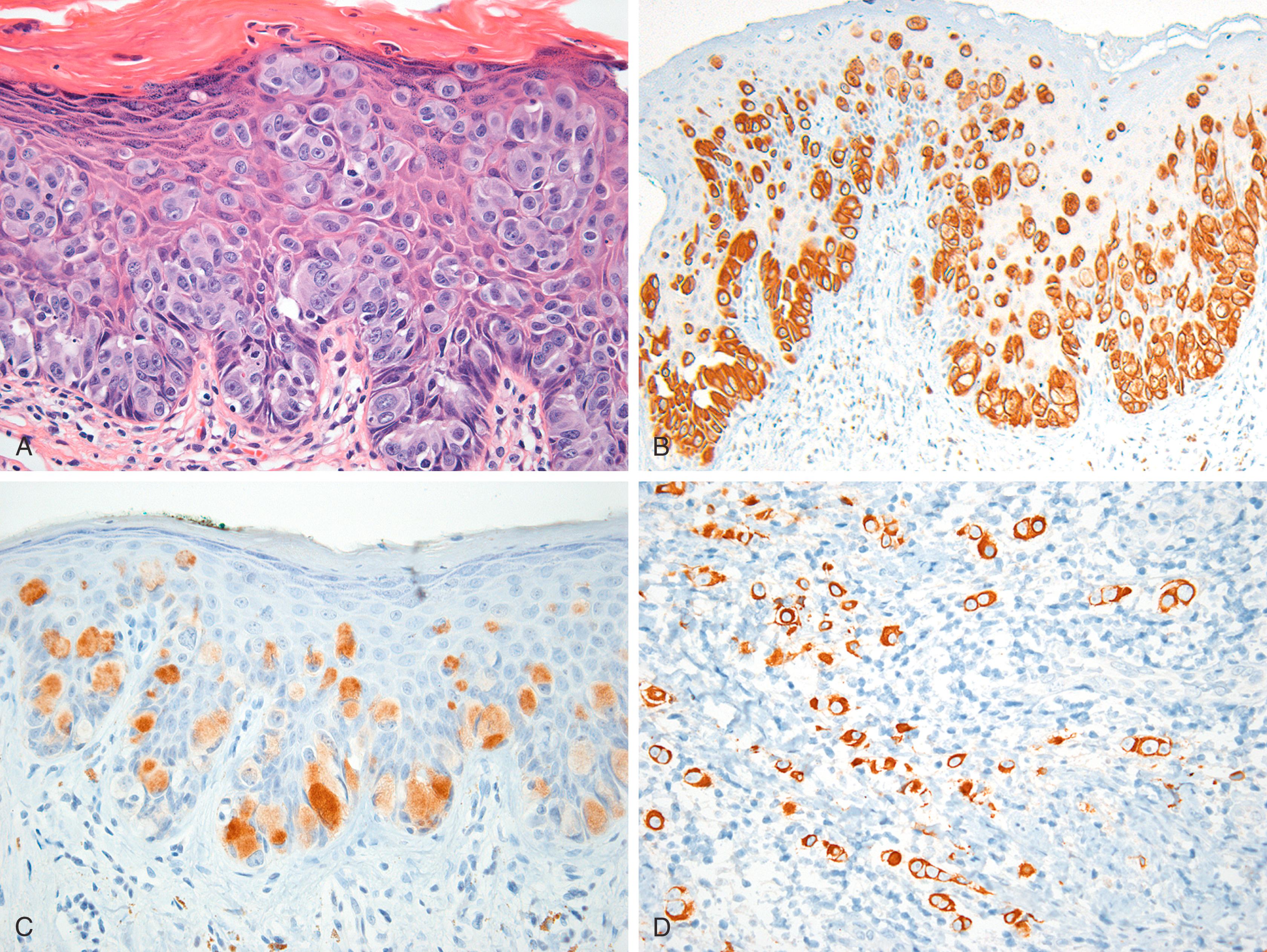
Vulvar melanoma and vulvar high-grade squamous intraepithelial lesions (HSILs) may rarely exhibit features that mimic vulvar Paget disease. Primary Paget disease tumor cells do not express the melanocytic markers S100, HMB-45, or SOX-10. , , Pagetoid HSILs do not express GCDFP but may express CK7; better markers to detect these are high-molecular-weight cytokeratin (HMWCK), p16, and p63. In situ hybridization for high-risk HPV is also valuable in this situation, as it will highlight the HSIL cells but not the Paget disease in the rare cases in which Paget disease may be positive for p16.
Primary vulvar Paget disease is typically positive for CK7 and GCDFP and is negative for CK20 and CDX2.
Secondary vulvar Paget disease of colorectal or urothelial origin shows a similar immunophenotype as the tumor at the primary site.
A panel approach is advised, because overlap of individual markers may rarely occur.
Pagetoid VIN is distinguished by expression of HMWCK, p16, and p63.
Pagetoid melanoma is distinguished by expression of S100, HMB-45, and SOX-10.
Although uncommon, a broad array of mesenchymal lesions may arise in the vulva or vagina. Among these, aggressive angiomyxoma is a mesenchymal neoplasm with a propensity for deep infiltrative growth and local recurrence that should be distinguished from its benign mimics, which include fibroepithelial polyp, angiomyofibroblastoma, cellular angiofibroma, myxoid leiomyoma, and nodular fasciitis. The relatively bland morphology of all these entities can make diagnosis problematic. Moreover, there is significant overlap of immunohistochemical expression in these tumor; almost all will express vimentin, ER, PR, and, to a variable extent, desmin, actin, and CD34. Cellular angiofibroma stands out in that it lacks actin and desmin expression. , Cellular angiofibromas have recently been shown to have monoallelic loss of chromosome region 13q, which contains that RB1 and FOX1 genes; this can be detected by FISH or by loss of Rb by immunohistochemistry ( Fig. 18.2 ). Gastrointestinal stromal tumors (GISTs) may rarely arise primarily in this location and mimic smooth muscle tumors; as in conventional GIST, CD117 and DOG1 expressions are characteristic. Proximal-type epithelioid sarcoma of the vulva is distinguished by the expression of keratin and EMA, and by loss of SMARCB1 (INI1). Rhabdomyosarcoma of the lower genital tract is distinguished by the expression of desmin and myogenin, although regenerating, reactive, and entrapped nonneoplastic skeletal muscle may also express myogenic markers. ,

Alternations in HMGA, an architectural transcription factor encoded on chromosome 12q15, can be seen in aggressive angiomyxomas. Nuclear immunoexpression of HMGA2 is present over half of aggressive angiomyxomas but is not specific, as it can also be positive in other vulvar mesenchymal lesions, including fibroepithelial stromal polyps and smooth muscle tumors.
Rhabdomyosarcomas in the lower genital tract show immunohistochemical evidence of skeletal muscle differentiation like rhabdomyosarcoma of any site. The spindle cells are positive for myogenin, MYOD1, and PAX7. Most cervical and vaginal rhabdomyosarcomas are embryonal type, and cervical embryonal rhabdomyosarcomas may be a manifestation of DICER1 syndrome, so genetic testing is suggested for individuals with these tumors.
Epithelioid sarcoma occurs in the gynecologic tract, with the vulva being the most frequent primary site. This malignant neoplasm shows expression of epithelial markers (cytokeratin, EMA); it is also positive for vimentin and can show CD34 expression. Loss of SMARCB1 (INI1) expression is seen in more than 90% of cases.
Classification of vulvar mesenchymal lesions is primarily based on morphologic criteria.
Most entities, including aggressive angiomyxoma, express vimentin, estrogen and progesterone receptors, and CD34.
Cellular angiofibroma lacks desmin, and actin expression may be focal. There is loss of Rb by immunohistochemistry.
Nuclear expression of HMGA2 may be seen in aggressive angiomyxomas, but it is not specific for this entity.
Granular cell tumors may occasionally arise in the vulva, and their appearance is similar to tumors at other anatomic sites. They are thought to derive from peripheral nerve sheath and express S100 protein, inhibin, and calretinin ( Fig. 18.3 ). , The diagnosis is usually straightforward, but occasionally the differential may include melanoma, histiocytes, or even a decidual reaction.
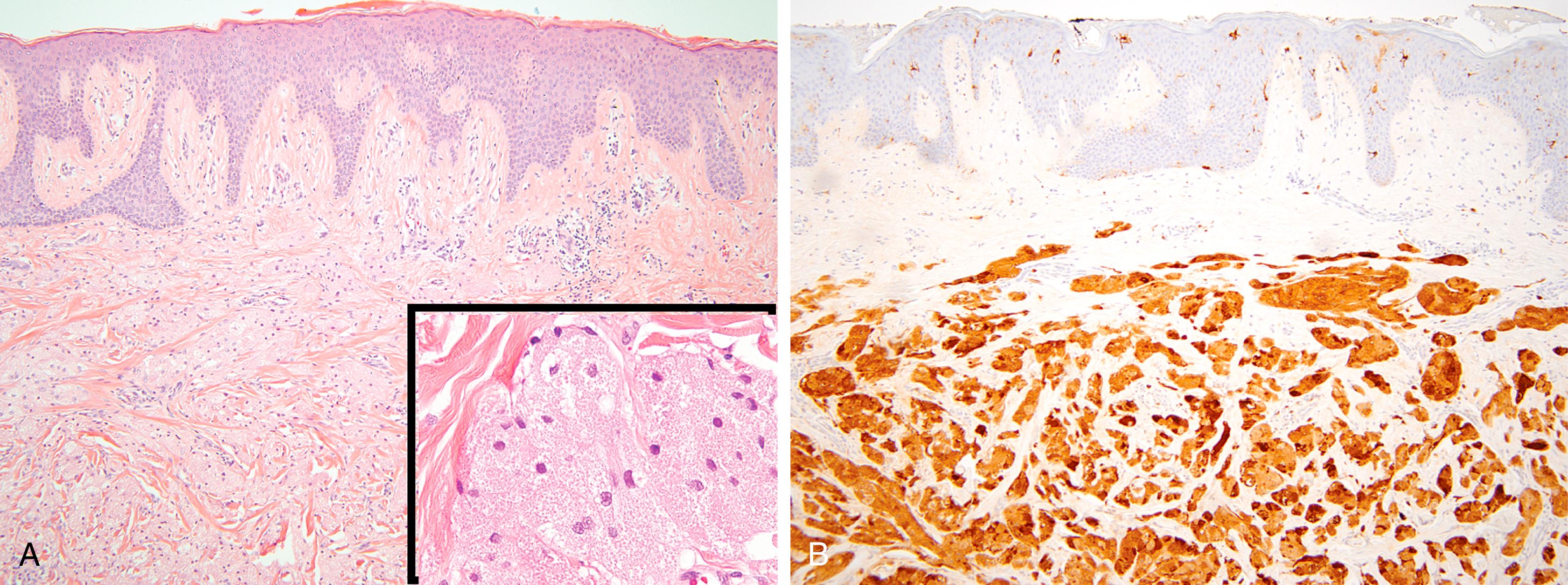
The main differential diagnosis for papillary squamous lesions of the vulva includes condyloma, fibroepithelial polyp, and squamous papilloma. Vulvar condyloma demonstrates papillomatosis, acanthosis, parakeratosis, and dyskeratosis but often lacks koilocytes, which makes the differential difficult in occasional cases. Molecular immunology Borstel 1 (MIB-1) is useful in this context. In normal vulvar epithelium, fibroepithelial polyp, and squamous papilloma, MIB-1 is confined to parabasal cells; in condyloma, MIB-1 expression occurs in the middle and upper third of the epithelium ( Fig. 18.4 ). Vulvar seborrheic keratosis may show increased MIB-1 expression, and focal p16 expression has been reported in rare cases; HPV type 6 has been detected in some vulvar seborrheic keratosis. As discussed later in the section on MIB-1 expression in the cervix, caution is advised in interpreting specimens with tangential sectioning or suboptimal orientation, because MIB-1 expression by normal parabasal cells could appear to be located in upper layers of epithelium.
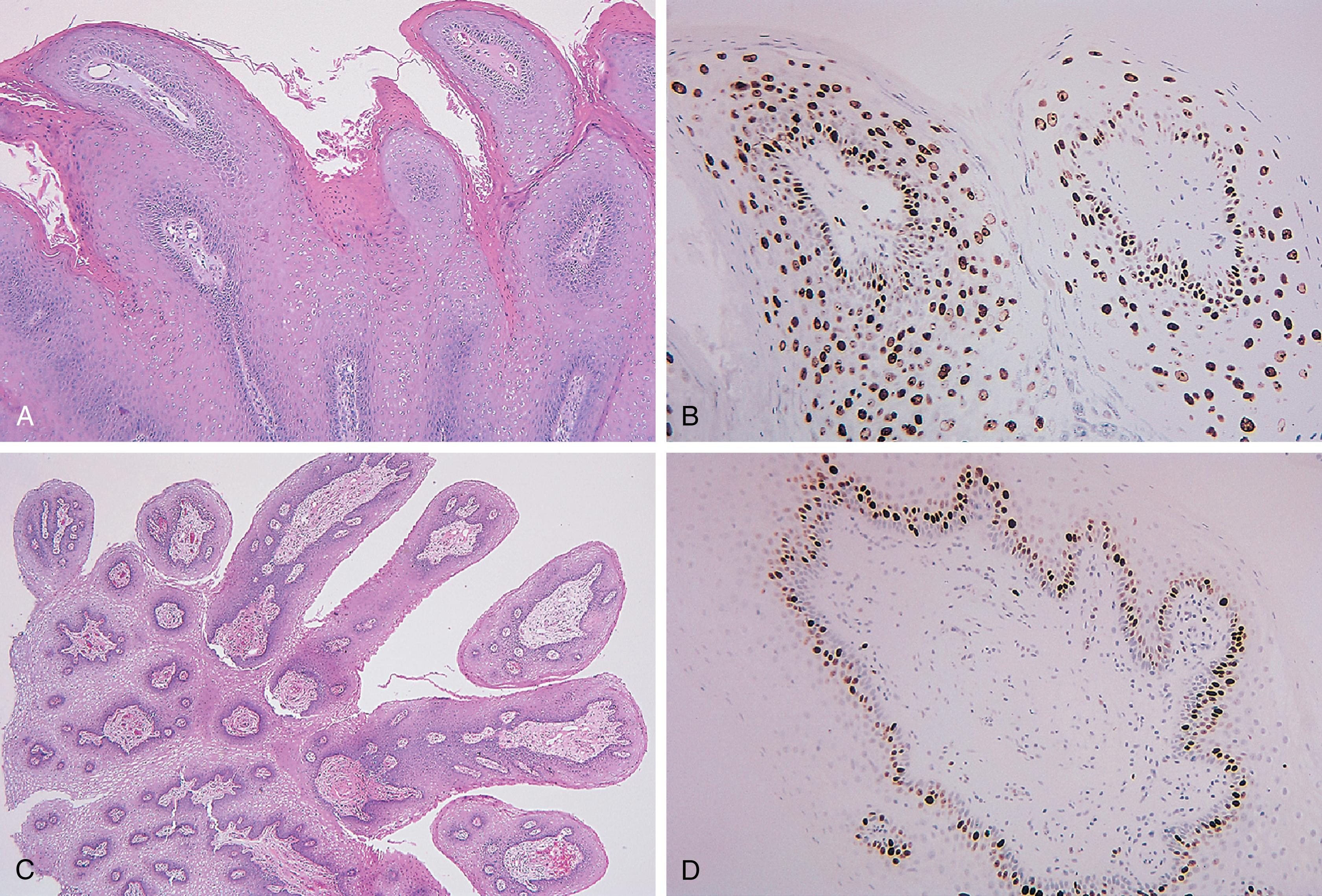
Immunohistochemical stains are useful in the diagnosis of vulvar HPV-related high-grade squamous intraepithelial lesions (HSIL) (vulvar intraepithelial neoplasia [VIN]) and in differentiated VIN. Normal and atrophic vulvar epithelia contain minimal MIB-1 expression in parabasal cells, whereas HSIL and dVIN show expression in the middle and upper epithelial layers. P16 should show diffuse nuclear and cytoplasmic expression in at least the lower third of the epithelium in HSIL, similar to the pattern seen in cervical HSIL. ,
Differentiated VIN is characterized by nuclear atypia and brisk mitoses confined to the basal zone; it is typically not associated with HPV, therefore p16 is usually absent. , Instead, dVIN may harbor p53 gene mutations; hence, p53 over-expression may be present, as characterized by diffuse strong nuclear staining in the basal and parabasal cells ( Fig. 18.5 ). , However, caution is warranted because reactive lesions can show increased p53 staining.
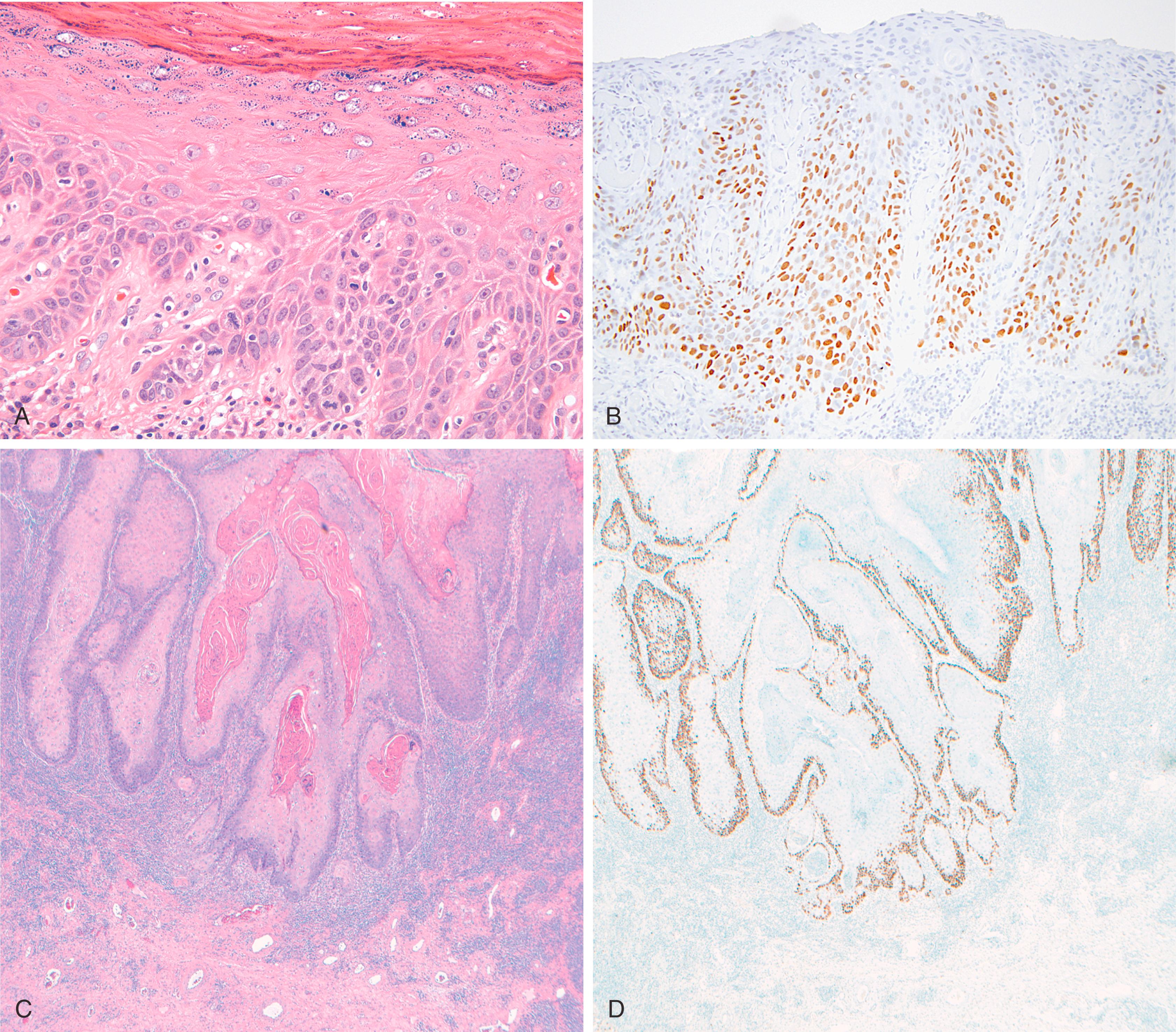
Invasive squamous cell carcinoma of the vulva can be HPV-associated or HPV-independent, as invasive tumors can arise from either HSIL or dVIN, respectively. The invasive tumors have a similar immunohistochemical profile to the precursor lesions, with diffuse p16 positivity in the HPV-associated tumors and p53 over-expression in the HPV-independent tumors.
Mesonephric duct remnants may be found in the deep wall of cervix specimens. Sometimes, hyperplasia may be pronounced and may raise concern for minimal deviation-type endocervical adenocarcinoma. Apical expression of CD10 is common in these remnants, as is expression by the intraluminal secretions. However, CD10 is not pathognomonic for mesonephric differentiation, because some endocervical and endometrial adenocarcinomas may also express it. However, minimal deviation-type endocervical adenocarcinoma lacks CD10 expression. Variable expression of p16 is reported in mesonephric remnants and may lead to misinterpretation as endocervical adenocarcinoma; however, strong, diffuse p16 expression is absent, and MIB-1 is not increased. PAX8 and thyroid transcription factor 1 (TTF-1) are frequently positive. ER, PR, and CEA are generally negative. Mesonephric adenocarcinoma exhibits a similar phenotype. GATA3, a transcription factor involved in embryogenesis and development, is as a useful marker of lower genital tract mesonephric lesions. It is frequently expressed in mesonephric remnants, hyperplasia, and adenocarcinoma but is rarely expressed in other neoplastic mimics in the cervix and endometrium. Overall, mesonephric carcinomas are variably positive for GATA-3, TTF-1, and calretinin with luminal CD10 staining and lack of estrogen expression, and they frequently harbor mutations in KRAS and NRAS .
The main diagnostic roles for IHC in the evaluation of cervical SILs are distinguishing dysplasia from benign mimics and evaluating cauterized margins. Grading dysplasia remains an issue to which morphologic criteria should be applied. The markers used most widely are MIB-1 and p16. MIB-1 can help to distinguish benign squamous lesions from SIL, but it is less helpful in distinguishing low- and high-grade SILs. Parabasal cells of normal cervical squamous epithelium express MIB-1, as do parabasal cells of immature squamous metaplasia, atrophy, and transitional cell metaplasia. In well-developed HSIL, full-thickness MIB-1 expression occurs. Lesser degrees of dysplasia will also demonstrate MIB-1 expression in cells above the basal layer to varying degrees ( Fig. 18.6 ). Proper tissue orientation is critical to interpreting MIB-1, because it depends on understanding the relationship between the basal layer and upper layers of epithelium. Tangential sectioning, suboptimal orientation, or artifactual loss of the outer layer of epithelium may lead to difficulty in determining whether an MIB-1-positive cell is part of the basal layer or some higher layer. In practice, we do not regularly use MIB-1 for cervical dysplasia and instead rely on morphology combined with p16 staining, as discussed below.
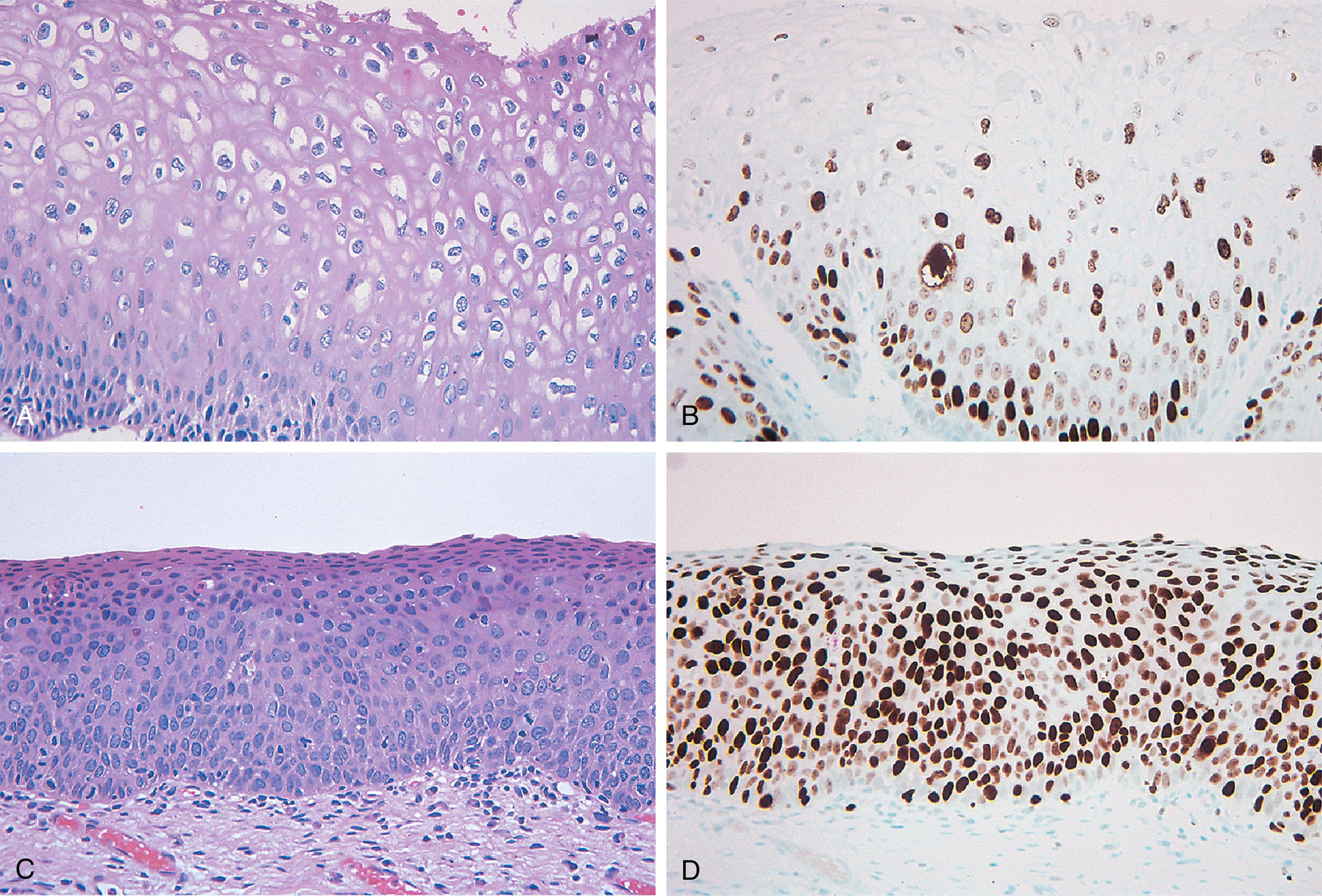
P16 expression is seen in most high-risk HPV-associated squamous lesions , , ; absent or occasional focal weak expression is seen in normal, inflamed, and atrophic cervical epithelium and in transitional cell metaplasia. In HSIL, diffuse, strong p16 staining of nuclei and cytoplasm should occur from at least the lower one-third to the entire full thickness of the epithelium, although not all cases are positive ( Fig. 18.7 ). , , In low-grade squamous intraepithelial lesions (LSIL), p16 expression is typically patchy, but diffuse positivity can be observed, so it is not recommended to stain morphologic LSIL with p16 (see Fig. 18.7 ). Positivity of p16 in LSIL appears to be a function of whether high-risk HPV is present, and it has been suggested that it may be a marker of progression to HSIL. , , However, a lesion should not be upgrade to HSIL solely on the basis of positive p16 staining. In situ hybridization (ISH) for high-risk HPV E6/E7 is available as a more HPV-specific alternative to p16 for tumors that are p16 positive but not necessarily HPV-related. Some have suggested that it could be useful for resolving issues of LSIL versus reactive change in the lower anogenital tract, but this is not yet routine practice.
MIB-1 expression in the upper layers of epithelium may distinguish HSILs from benign mimics, as does diffuse p16 expression.
Tangential sectioning or loss of the outer layer of epithelium may make interpretation of MIB-1 difficult, because it is expressed in the parabasal cells of benign cervical epithelium.
In practice, p16 is used routinely in cases where the morphologic differential includes an HSIL but benign mimics need to be excluded (atrophy, squamous metaplasia). P16 can be positive in LSIL, so screening of morphologic LSIL lesions is not recommended.
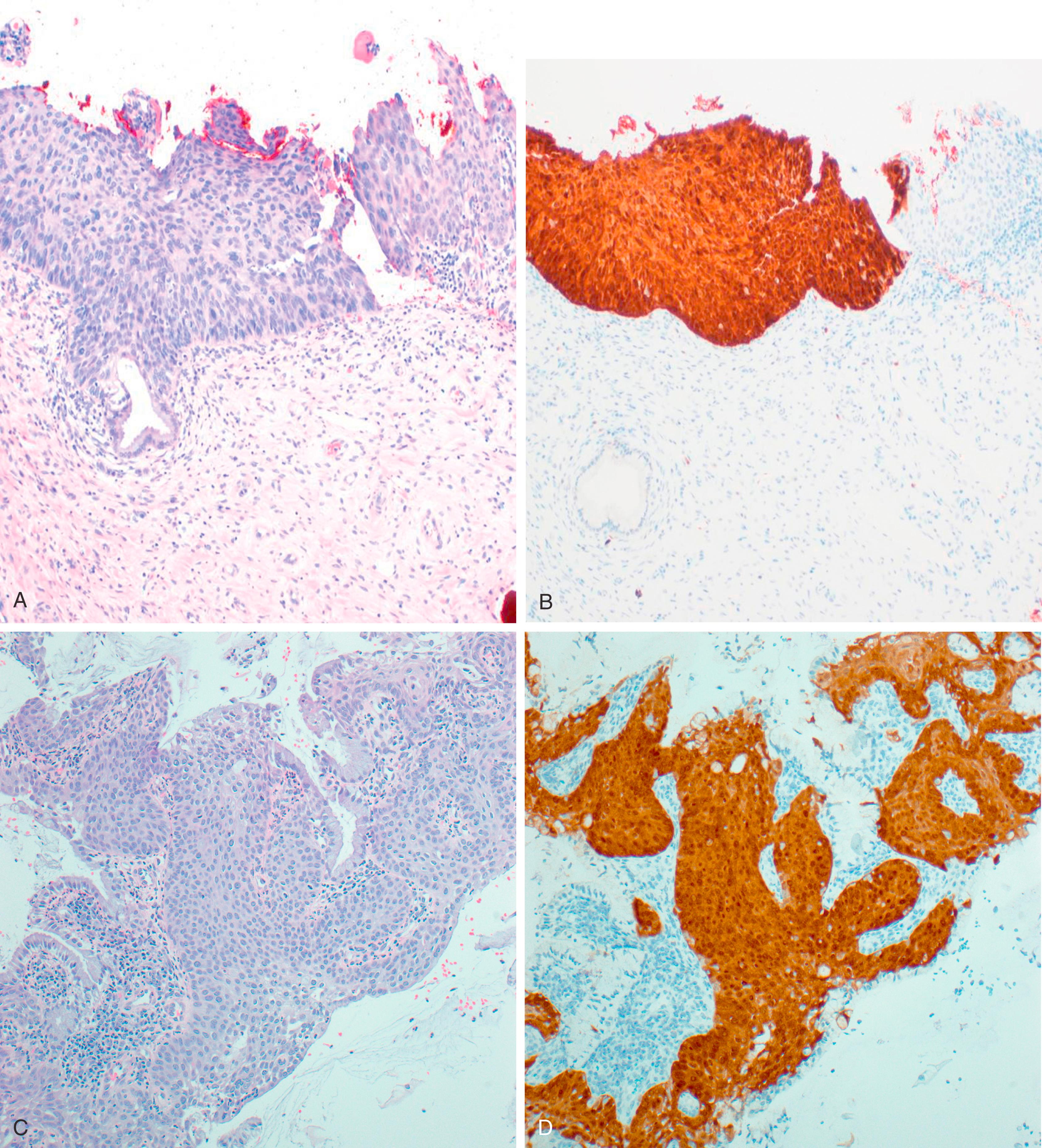
Two diagnostic issues arise with HPV-associated endocervical adenocarcinoma in situ (AIS): distinguishing it from benign mimics and assessing for stromal invasion. IHC can help with the former but not the latter. The constellation of nuclear enlargement, hyperchromasia, crowding, atypia, mitoses, and cribriform growth define endocervical adenocarcinoma in situ. Tubal metaplasia, microglandular hyperplasia, endometriosis, and inflammatory changes may sometimes harbor one or more of these features. Endocervical adenocarcinoma in situ expresses increased MIB-1 and p16 (diffuse and strong), but not ER, PR, or vimentin ( Fig. 18.8 ). mCEA has also been used in this distinction, but it adds little additional information beyond that of p16/HPV in situ, ER/PR, and vimentin. Tubal metaplasia and endometriosis show cytoplasmic Bcl-2 but no increase in MIB-1 or CEA; p16 can range from focal to patchy. Microglandular hyperplasia also lacks increased MIB-1, p16, and CEA. , , ,
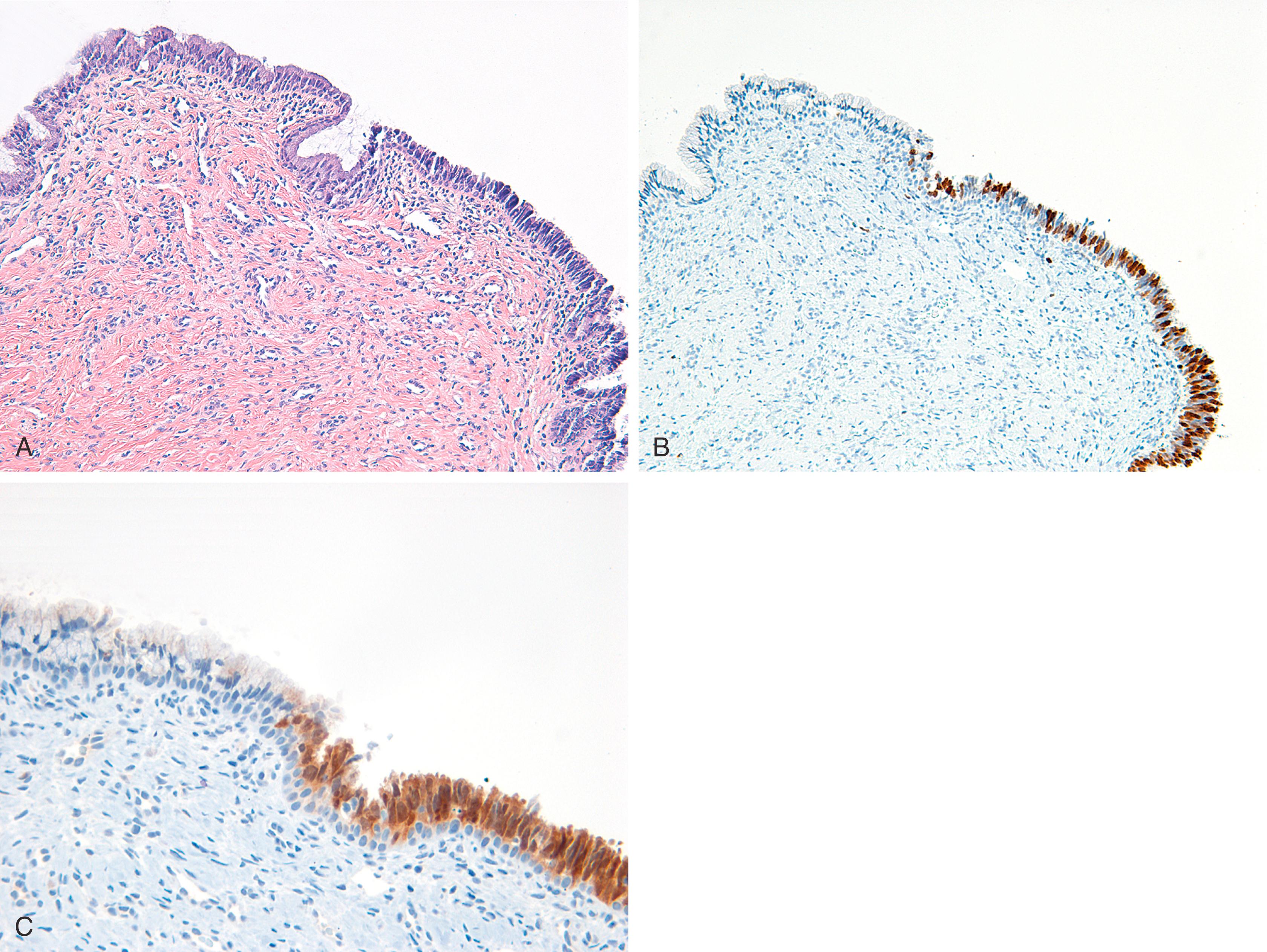
HPV-independent endocervical adenocarcinoma in situ is a more recently recognized entity. It is characterized by gastric-type differentiation and represents the presumed precursor to HPV-independent adenocarcinomas with gastric differentiation. HPV-independent AIS is positive for CK7 and MUC6, with frequent expression of CDX2 and PAX8. A subset shows abnormal p53 expression, which can be very helpful to support the diagnosis. Because this lesion is HPV-independent, it typically shows absent or patchy expression of p16. Most cases are negative for estrogen and progesterone receptor.
HPV-associated endocervical AIS is distinguished from endocervical glandular metaplasia, hyperplasia, and endometriosis by strong diffuse p16 expression.
HPV-independent endocervical AIS lacks diffuse p16 expression and is characterized by positivity for CK7 and MUC6 and loss of hormone receptor expression. P53 can show abnormal expression.
Become a Clinical Tree membership for Full access and enjoy Unlimited articles
If you are a member. Log in here